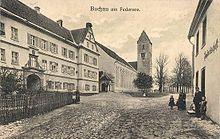This article has multiple issues. Please help improve it or discuss these issues on the talk page. (Learn how and when to remove these messages)
|
| Imperial Abbey of Buchau on the FederseeReichsstift Buchau am Federsee | |||||||||
|---|---|---|---|---|---|---|---|---|---|
| 1347–1803 | |||||||||
| Status | Imperial Abbey | ||||||||
| Capital | Buchau Abbey | ||||||||
| Common languages | Alemannic | ||||||||
| Government | Elective principality | ||||||||
| Historical era | Early modern period | ||||||||
| • Founded | 770 | ||||||||
| • Raised to princely status, gained Imp. immediacy | 1347 | ||||||||
| • Converted to secular foundation | 1415 | ||||||||
| • Gained sovereignty over Straßberg | 1625 | ||||||||
| • Mediatised to Thurn und Taxis | 1803 | ||||||||
| • Ceded to Württemberg | 1806 | ||||||||
| |||||||||
| Today part of | Germany | ||||||||
Buchau Abbey, otherwise the Imperial Abbey of Buchau (German: Reichsstift Buchau), was a self-ruling Imperial Estate and its abbess had a seat and vote at the Imperial Diet.
History
According to tradition, the monastery was founded around 770 on an island in the Federsee by the Frankish Count Warin, his wife Adelindis von Buchau (still commemorated in the local Adelindisfest).


Whether Buchau was initially a house of canonesses regular or a Benedictine abbey is unclear. The abbey was put on a secure financial footing by Louis the Pious, who in 819 granted the nuns property in Mengen. In 857, Louis the German declared it a private religious house of the Carolingian Imperial family, appointed as abbess his daughter Irmingard (died 16 July 866), and granted the abbey lands at Saulgau.
In the 13th century the town of Buchau, which had grown up in the immediate vicinity of the abbey, gained the status of a Free imperial city after a long period of strife between the townspeople and the abbey. From then on and until 1803, Buchau Abbey and the Imperial City of Buchau, both self-governing entities fully independent of each other, were compelled to coexist. Unlike most of the other Free Imperial Cities, Buchau was to remain Catholic in the course of the Reformation.
In 1347, Buchau Abbey gained Imperial immediacy and the abbess was raised to the rank of Princess-Abbess. The abbey was an Imperial Estate and its abbess had a seat and vote at the Imperial Diet.

In 1415, the abbey became a secular foundation and from then on the congregation was to be composed of an abbess, twelve canonesses choral (choir women or Chorfrauen) and two chaplains. Buchau Abbey had a small territorial base and in 1625 the lordship of Strassberg also became part of the abbey's possessions.
In the course of the secularisation of 1803, Buchau Abbey was dissolved like all the other Imperial abbeys and its territory and assets passed first to the prince of Thurn und Taxis, then to the Kingdom of Württemberg in 1806. The lordship of Strassberg however was annexed to the Principality of Hohenzollern-Sigmaringen.
The abbey church of Saints Cornelius and Cyprian, one of the first neo-classical buildings in southern Germany and still showing some late Baroque features, was built between 1774 and 1776 by Pierre Michel d'Ixnard as a conversion and refurbishment of a Gothic church. It includes stucco sculptures by Johann Joseph Christian.

References
- ^ Schmitt O.S.B., Miriam. "St. Irmengard", Medieval Women Monastics, (Miriam Schmitt, Linda Kulzer, eds.) Liturgical Press, 1996, p. 121 ISBN 9780814622926
Further reading
- Johann Daniel Georg v. Memminger: Stift Buchau, aus Beschreibung des Oberamts Riedlingen. Cotta, Stuttgart and Tübingen 1827 (full text on Wikisource)
- Rudolf Seigel (ed.): Die Urkunden des Stifts Buchau. Regesten 819–1500. (= "Inventare der nichtstaatlichen Archive in Baden-Württemberg"; Bd. 36). Kohlhammer, Stuttgart 2009 ISBN 9783170207837
- Bernhard Theil: Das (freiweltliche) Damenstift Buchau am Federsee. (= "Germania sacra", N. F., Bd. 32; Das Bistum Konstanz, Teil 4), publ. Max-Planck-Institut für Geschichte. De Gruyter, Berlin 1994.p. 422 ISBN 3110142147 (online version at Google Books)
- Volker Himmelein (ed.): Alte Klöster, neue Herren. Die Säkularisation im deutschen Südwesten 1803. Große Landesausstellung Baden-Württemberg 2003; Ostfildern: Thorbecke, 2003 ISBN 3799502122 (exhibition catalogue and collection of essays)
External links
- [REDACTED] Media related to Buchau Abbey at Wikimedia Commons
- (in German) Klöster in Baden-Württemberg: Adelige Chorfrauenstift Buchau -Geschichte
- (in German) Map of Swabia, 1789
- (in German) Das (freiweltliche) Damenstift Buchau am Federsee at Google Books, by Bernhard Theil, 1994. ISBN 978-3-11-014214-3
| Imperial abbeys and colleges (Reichsabteien, Reichsklöster und Reichsstifte) |  | |
|---|---|---|
| Imperial provostries and priories (Reichspropsteien) | ||
| Imperial charterhouse (Reichskartause) | ||
| * Also a Prince of the Empire † Also in Swabian College | ||
48°4′3″N 9°36′42″E / 48.06750°N 9.61167°E / 48.06750; 9.61167
Categories:- Imperial abbeys
- Monasteries in Baden-Württemberg
- Augustinian monasteries in Germany
- Monasteries of Canonesses Regular
- Christian monasteries established in the 8th century
- 8th-century establishments in Germany
- Imperial abbeys disestablished in 1802–03
- 1340s establishments in the Holy Roman Empire
- 1347 establishments in Europe
- 1803 disestablishments in the Holy Roman Empire
- Buildings and structures in Biberach (district)
- 770 establishments
- Churches completed in the 770s
- 8th-century churches in Germany
